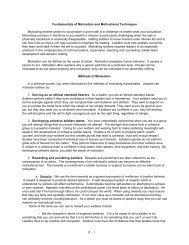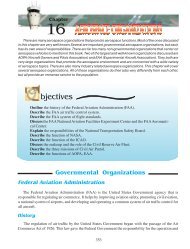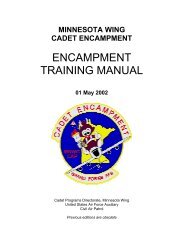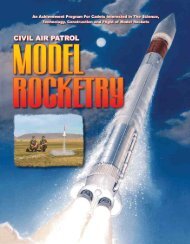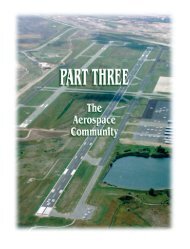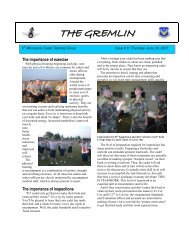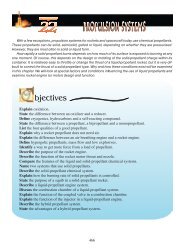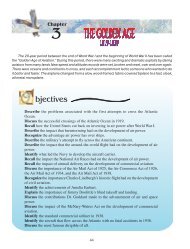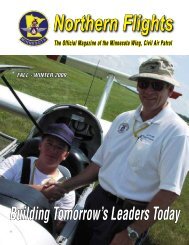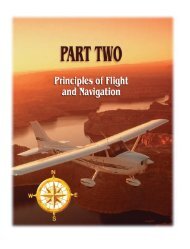and ambiguity, aspiring strategic leaders can neverthelesslearn to master it. Indeed, by acquiring certain skills andcompetencies, they can transform this environment intosomething more stable, certain, simple, and clear.DEVELOPING STRATEGIC <strong>LEAD</strong>ERSHIPIf becoming a strategist is the “ends,” then leadership isthe “ways,” and development is the “means.” Learning tobecome a strategic leader requires special preparation inseveral areas. First, one must understand how such aleader develops—in essence the anatomy of strategic leadership.Second, one should recognize some of the essentialcompetencies a strategic leader must have. Finally, theprospective leader needs to assess his or her current abilitiesand commit to a development plan.ANA<strong>TO</strong>MY OF A STRATEGIC <strong>LEAD</strong>ERDevelopment of a strategic leader involves a number ofimportant aspects. First, the most important, indeedfoundational, part of this preparation concerns values,ethics, codes, morals, and standards. Second, the path tostrategic leadership resembles the building of a pyramid(fig. 2). Shortcuts do not exist, and one can’t start at thetop—strategic leaders are made, not born. Strategic leadersgradually build wisdom, defined as acquiring experiencesover time. 7 One must also remember that certain activitiescan accelerate these experiences and widen perspectives.Leaders should know that even though some individualswith strategic competency may not become strategicdecision makers, they can still influence and contributeto decisions. Additionally, having strategic competencywill allow one to fully understand strategic decisions andperspectives.Figure 2COMPETENCIESIt is difficult to imagine an all-inclusive list of competenciesrequired for strategic leadership. However, some skillsseem essential— vision, for instance, which allows thestrategic leader to focus on the future and, in fact, buildthat future. Vision makes leaders proactive in the strategicenvironment rather than reactive. Furthermore, theyshould become transformational in order to inspire peopletoward common goals and shared values; they mustanticipate change, lead change, and foster a mind-set ofchange; they should critically analyze their own thinkingto make decisions logically; they should foster an attitudeof creativity in their operations and organizations; theymust audaciously seek novel ideas and understand how toframe decisions and organize chaos; and they shouldknow how to build effective teams and gain consensuswithin large organizations. When consensus fails, strategicleaders must negotiate effectively, or they put success atrisk. Many times, this kind of success is directly relatedto the cultural sensitivity and cross-cultural communicationsability of the leader. Finally, the strategic leadermust assume the role of both teacher and mentor. As NoelTichy reminds us, great leaders are great teachers. Theyhave a teachable point of view and invest in developingother leaders. 8 The competencies mentioned above formthe basis of an education for aspiring strategic leaders.ASSESSMENT AND DEVELOPMENTBecoming a strategic leader is a daunting challenge. Itstarts with taking stock of leadership abilities, conceptualcapacity, and interpersonal skills. A thorough self-assessmentwill help identify strengths and weaknesses. Suchassessments can examine personality type, leadershipmotivation, originality, innovation, tolerance, teamwork,and conceptual ability. These assessments are like thestarting point on a map, letting prospective leaders knowwhere they are so they can take the best route to theirdestination. Completing a detailed self-assessment is alsothe first step in commitment to the personal and professionaldevelopment process required to become a strategic leader.As a follow-up to the self-assessment, aspiring leadersshould ask themselves a series of questions: What are mystrengths? How can I capitalize on them? Where are myweaknesses? What can I do about them? Where do I wantto be in the future? How can I get there? Do I really wantto commit to development? The last question is the mostdifficult one. 9 Those who answer yes are ready to beginthe journey toward becoming strategic leaders.At this point, leader candidates should volunteer for andaccept challenging assignments—especially in areas in14
which they might not have worked before. These couldinclude moving into a different functional area, acceptingjoint assignments, or working in an interagency environment.Such taskings tend to accelerate experience andbroaden perspectives. Furthermore, pursuing a formalcourse of study at senior service colleges and participatingin other education programs would broaden one’s knowledgeand conceptual ability. Self-learning is also valuable—especially reading. All strategic leaders are voraciousreaders—and they read outside their normal area ofexpertise, again, to expand their perspective and increasetheir conceptual ability. In fact, many of them are expertsin a number of unrelated fields. Becoming a “dual expert”helps one think in multiple dimensions.After committing to some or all of these developmentactivities, potential leaders should reflect on each activityas a way of mining the total benefit and seeking greatermeaning. They will also benefit from mentoring otherleaders and being mentored themselves. When mentorsshare their experiences, they help others know andunderstand them. As Tichy says, sharing experiences or“telling stories” shapes our own attitude, behavior, andpoint of view. 10 We become the story, and the story guidesour lives. Gen Dwight Eisenhower endorsed mentoringwhen he explained that the best way to become a gooddecision maker is to be around others who make decisions. 11CONCLUSIONThe many components of the strategic leadership environmentchallenge even the best leaders. The monumentalconsequences of strategic decisions call for individualswith unique performance abilities who can navigate thevolatility, uncertainty, complexity, and ambiguity inherentin the nature of those decisions. Aspiring leaders can riseto the challenge by undergoing self-assessment and personaldevelopment. Accepting the demands of strategicleadership involves a transition from the art of the familiarto the art of the possible. This is the realm of strategicleadership and the strategic environment.NOTES1. Webster’s II New Riverside University Dictionary, 1988 ed., s.v.“strategic.”2. T. Owen Jacobs, Strategic Leadership: The Competitive Edge(Fort Lesley J. McNair, Washington, D.C.: Industrial College of theArmed Forces, 2000), 24.3. US Industrial College of the Armed Forces, chap. 1, “Overview,”Strategic Leadership and Decision Making: Preparing Senior Executivesfor the 21st Century (Washington, D.C.: National Defense UniversityPress, 1997), on-line, Internet, September 2000, availablefrom http://www.ndu.edu/inss/books/books%20-%201999/Strategic%20Leadership%20and%20Decision-making%20-%20Feb%2099/cont.html.4. Ibid.5. Ibid.6. Ibid.7. Jacobs, 46.8. Noel M. Tichy with Eli Cohen, The Leadership Engine: How WinningCompanies Build Leaders at Every Level (New York: HarperBusiness, 1997), 3.9. US Industrial College of the Armed Forces, chap. 7, “DevelopingStrategic Leaders,” Strategic Leadership and Decision Making.10. Tichy and Cohen, 77.11. Edgar F. Puryear Jr., American Generalship: Character Is Everything:The Art of Command (Novato, Calif.: Presidio Press, 2000),232.Col Guillot is a former cadet from Louisiana and arecipient of the Spaatz Award.From: Col W. Michael Guillot, “Strategic Leadership: Defining theChallenge,” <strong>Air</strong> & Space Power Journal (Winter 2003): 67-75. Usedwith permission.15
- Page 1 and 2: VOLUME FOUR STRATEGIC PERSPECTIVESL
- Page 3 and 4: VOLUME FOUR STRATEGIC PERSPECTIVESL
- Page 5 and 6: VOLUME FOUR STRATEGIC PERSPECTIVESL
- Page 7: VOLUME FOUR STRATEGIC PERSPECTIVESL
- Page 10 and 11: 12CHAPTER 12INTRODUCTION TO STRATEG
- Page 12 and 13: 12.1 Strategic Leadership: Defining
- Page 14 and 15: mandates or resolutions that would
- Page 18 and 19: 12.2 National Security StrategyThe
- Page 20 and 21: within our borders has always been
- Page 22 and 23: front common challenges like violen
- Page 24 and 25: and our strategy, not sector earmar
- Page 26 and 27: thinking about organizations. She m
- Page 28 and 29: A systemic approach to failure is m
- Page 30 and 31: The late W. T. Grant Company is a r
- Page 32 and 33: the resources - setting the directi
- Page 34 and 35: focal point for describing and inte
- Page 36 and 37: Consequently, we do not restrict th
- Page 38 and 39: paragraphs, Web pages, then edit an
- Page 40 and 41: Web, can be viewed as a CS attempt
- Page 42 and 43: How to evaluate users and contribut
- Page 44 and 45: 13CHAPTER 13LEADING PUBLIC &VOLUNTE
- Page 46 and 47: 13.1 Leadership for Volunteers:The
- Page 48 and 49: 13.2 Take Root: Volunteer Managemen
- Page 50 and 51: QualificationsClearly list educatio
- Page 52 and 53: and effectively track their volunte
- Page 54 and 55: • Understand rules for recognitio
- Page 56 and 57: • Send a birthday card.• Submit
- Page 58 and 59: and tested more than six decades af
- Page 60 and 61: specific interests of the donors, v
- Page 62 and 63: tain) tax-exempt status from the In
- Page 64 and 65: Smucker, 1999).The Internal Revenue
- Page 66 and 67:
culture is necessary to ensure the
- Page 68 and 69:
13.4 The New Look of TransparencyBy
- Page 70 and 71:
ees for a couple of reasons: One, i
- Page 72 and 73:
13.5 Public and Private Management:
- Page 74 and 75:
TABLE 1:FUNCTIONS OF GENERAL MANAGE
- Page 76 and 77:
3. Career System. The model corpora
- Page 78 and 79:
islative charter - the Clean Air Ac
- Page 80 and 81:
In controlling performance, Chapin
- Page 82 and 83:
14CHAPTER 14AIRPOWER ASSTRATEGIC LA
- Page 84 and 85:
14.1 Strategic Air Power: Fulfillme
- Page 86 and 87:
carry it out. Their daylight raids
- Page 88 and 89:
you did not rely on strategic bombi
- Page 90 and 91:
14.2 Warden and the Air Corps Tacti
- Page 92 and 93:
ecomes one of applying sufficient i
- Page 94 and 95:
tification, and a Jominian claim to
- Page 96 and 97:
courage the rapid and widespread ex
- Page 98 and 99:
it to influence physical players in
- Page 100 and 101:
14.4 Basic Air Force DoctrineAF Doc
- Page 102 and 103:
earthquake-stricken Haiti. The worl
- Page 104 and 105:
perspective. Airmen do not divide u
- Page 106 and 107:
Command and ControlCommand and cont
- Page 108 and 109:
14.5 Should the US Maintain the Nuc
- Page 110 and 111:
form of human government.” 20 Dem
- Page 112 and 113:
obtainable goal. See the Global Zer
- Page 114 and 115:
15CHAPTER 15ORGANIZATIONAL CULTURE
- Page 116 and 117:
15.1 Organizational CultureBy Doria
- Page 118 and 119:
Review. This action strives to unco
- Page 120 and 121:
gram will serve and then having the
- Page 122 and 123:
ticipating the changes being made b
- Page 124 and 125:
Many years of working with change p
- Page 126 and 127:
At the least, the areas of concern
- Page 128 and 129:
15.4 Developing an Innovative Cultu
- Page 130 and 131:
CONCLUDING THOUGHTSIn an ever-chang
- Page 132 and 133:
global issues. Businesses that poss
- Page 134 and 135:
— Sees the big picture—the shif
- Page 136 and 137:
16CHAPTER 16STRATEGIC COMMUNICATION
- Page 138 and 139:
16.1 Principles of Strategic Commun
- Page 140 and 141:
16.2 The Art of NegotiationBy Brend
- Page 142 and 143:
16.3 Negotiating Effectively Across
- Page 144 and 145:
hidden areas can act as cultural ho
- Page 146 and 147:
and four conflict styles. Hammer be
- Page 148 and 149:
maintaining the relationship. As th
- Page 150 and 151:
25 Mitchell R. Hammer, “Chapter 1
- Page 152 and 153:
tural, socioeconomic, and psycholog
- Page 154 and 155:
for the win-win," during which time
- Page 156 and 157:
interests and, at worst, as a gun s
- Page 158 and 159:
Public diplomacy is surely about mu
- Page 160 and 161:
But public diplomats do not have th
- Page 162 and 163:
Photo courtesy of the familyThe LEA
- Page 164:
THE CADET OATHI pledge that I will



